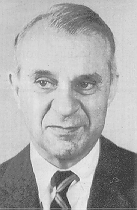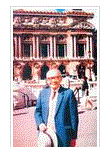 W.Leontief
W.Leontief他編制的美國經濟體系投入產出表,把美國經濟體系劃分成41個部門,後來又分成450個部門。
把它們歸併為工業和農業兩大部門。
Wassily Leontief's name has been associated with a particular type of quantitative economics: input-output analysis. Input-output was partly inspired by the Marxian and Walrasian analysis of general equilibrium via interindustry flows - which in turn were inspired by Quesnay's tableau Economique, and was the outgrowth of the "multi-sectoral" approach followed by the Kiel School. Although of fluctuating popularity, input-output analysis has been a mainstay of economics and economic policy and planning throughout the world for the past half-century.
Raised in Russia, Leontief obtained his Ph.D in Berlin. Although the seeds of input-output analysis were already in his work at the Kiel Institute, he would have to wait until he reached Harvard in 1932 to begin constructing an empirical example of his input-output system - an effort which gave rise to his 1941 classic, Structure of American Industry. Leontief followed up this work with a series of classical papers on input-output economics (collected in 1966). Input-output was novel and inspired large-scale empirical work. It has been used for economic planning throughout the world, whether in Western, Socialist or Third World countries.
It was also of crucial theoretical importance. Input-output inspired the analysis of linear production systems, which were instrumental in the development of modern Neo-Walrasian theory. Unusual for most economic contributions, Leontief's system was also crucial for the revival of Classical Ricardian theory. The structure of input-output (albeit with some critical differences) was employed by Piero Sraffa and the Neo-Ricardians in the 1960s to resurrect the theories of Ricardo and Marx.
Leontief's contributions to economics were not limited to input-output. His 1936 article on "composite commodities" made him, together with Hicks, the father of that famous microeconomic theorem. His early reviews of Keynes's General Theory (1936, 1937, 1947, 1948) were important stepping stones to the Neo-Keynesian synthesis's stress on fixed nominal wages in interpreting Keynes's theory. His 1933 article on the analysis of international trade is still learnt today and his 1946 contribution on the wage contract outlined what is now a classical application of the principal-agent model before that term was invented. One of his more stirring contributions has been his 1953 finding that Americans were exporting labor-intensive rather than capital- intensive goods - the "Leontief Paradox" - which brought into question the validity of the conventional factor-proportions theory of international trade.
After having presided, together with Schumpeter, as a teacher over the Harvard generation of the 1930s which was to develop much of post-war economics, Leontief moved to the C.V. Starr Center at New York University. As a critic, Leontief's repeated admonishment of economics for its misuse of mathematics and quantitative methods and the lack of relevance and Realism in its theorizing (e.g. 1938, 1954, 1959, 1971) are both lucid, sharp and still pertinent. It was for his development of input-output that Wassily Leontief won the Nobel memorial prize in 1973.
Major Works of Wassily Leontief
"The Use of Indifference Curves in the Analysis of Foreign Trade", 1933, QJE.
"Delayed Adjustment of Supply and Partial Equilibrium", 1934, ZfN.
"The Fundamental Assumption of Mr. Keynes's Monetary Theory of Unemployment", 1936, QJE.
"Composite Commodities and the Problem of Index Numbers", 1936, Econometrica.
"Implicit Theorizing: a methodological criticism of the Neo-Cambridge school", 1937, QJE.
"The Significance of Marxian Economics for Present-Day Economic Theory", 1938, AER.
The Structure of the American Economy, 1919-1939, 1941.
"The Pure Theory of the Guaranteed Annual Wage Contract", 1946, JPE.
"Introduction to a Theory of the Internal Structure of Functional Relationships", 1947, Econometrica.
"Wages, Profits, Prices and Taxes", 1947, Dun's Review.
"Postulates: Keynes's General Theory and the classicists", 1947, in Harris, editor, The New Economics.
"Note on the Pluralistic Interpretation of History and the Problem of Interdisciplinary Co-operation", 1948, J of Philosophy.
"Input-Output Economics", 1951, Scientific American.
"Machines and Man", 1952, Scientific American.
Studies in the Structure of the American Economy, 1953.
"Domestic Production and Foreign Trade: the American capital position re-examined", 1953, Proceedings of American Philosophical Society.
"Mathematics in Economics", 1954, Bulletin of the AMS.
"Factor Proportions and the Structure of American Trade: Further theoretical and empirical analysis", 1956, REStat.
"Theoretical Note on the Time-Preference, Productivity of Capital, Stagnation and Economic Growth", 1958, AER.
"The Problem of Quality and Quantity in Economics", 1959, Daedalus.
"The Rise and Decline of Soviet Economic Science", 1960, Foreign Affairs.
"The Economic Effects of disarmament", with M. Hoffenberg, 1961, Scientific American.
"The Rates of Long Run Growth and Capital Transfer from Developed to underdeveloped Areas", 1963, Proceedings of Conference on Role of Econometric Analysis.
"Modern Techniques for Economic Planning and Projection", 1963, Scuola in Azione.
"Multiregional Input-Output Analysis", with A. Strout, 1963, in Barna, editor, Structural Intedependence...
"The Structure of Development", 1963, Scientific American.
"When Should History be written Backwards?", 1963, Economic History Review.
"Proposal for Better Economic Forecasting", 1964, Harvard Business Review.
"On Assignment of Patent Rights on Inventions Made under Government Research Contracts", 1964, Harvard Law Review.
"Input-Output Analysis", 1965, Scientific American.
Input-Output Economics, 1966.
Essays in Economics: Theories and theorizing, 1966.
Essays in Economics, 1966.
"Theoretical Assumptions and Non-Observed Facts", 1971, AER.
"Structure of World Production: Outline of a simple input-output formulation", 1974, AER
The Future of the World Economy, with A.P. Carter and P. Petri 1977.
Military Spending, with F. Duchin, 1983
The Future Impact of Automation on Workers, with F. Duchin, 1986.
"Money-Flow Computations", with A. Brody, 1993, Econ Systems Research
Resources on Wassily Leontief
HET Pages: Classical Ricardian System: Closed Leontief Model, Open Leontief Model, Dynamic Leontief Model, Composite Commodities
Autobiography of Leontief at Nobel site.
Press release of Nobel award (1973).
Wassily Leontief Memorial Page at MIT
"Leontief: A Life in Economics" by Turi McKinley
Wassily Leontief's Sketches and Drawings
Photos from Leontief's Life
"Our Wassily: W.W. Leontief (1905-1999)" by Paul Samuelson
"Technological Advancement, Employment and the Distribution of Income between Labor and Capital" by W. Leontief, 1994
Leontief Page at Nobel Prize Internet Archive
"Wassily Leontief: A Note" by James K. Galbraith
The International Input-Output Association website
Biography of Leontief at Nobels for the Future.
Leontief's Input-Output Model - an example.
Leontief Center, in St. Petersburg, Russia
Leontief page at Britannica.com
Leontief page at Britannica Guide to the Nobel Prizes
Leontief bio
Leontief page in German
"The Leontief Paradox" at Iowa State
Leontief Page at Laura Forgette
Leontief entry at Bartleby

